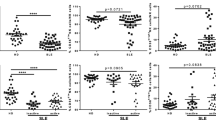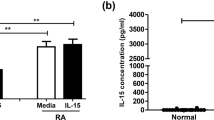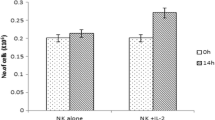Abstract
Behçet’s disease (BD) is a systemic, autoinflammatory, chronic disorder which affects various parts of the body in genetically susceptible individuals. BD has a multi-factorial etiopathogenesis which encompasses both innate and adaptive arms of immunity. NK cells, which kill virus-infected or malign cells and provide interaction between adaptive and innate immune system, are also known to involve in the pathogenesis of autoimmune/autoinflammatory diseases including BD. NK cells function in immune responses via the signals obtained from surface-expressed activating and inhibitory receptors. In this study, we aimed to explore NK cell activation status by measuring the levels of activation marker CD69 and activating receptors NKG2D, NKp30, and NKp46 as well as proliferative and cytotoxic capacities in response to stimulation with interleukin (IL)-15-combined cytokines in BD patients. CD4+ and CD8+ T cell responses were also evaluated to compare with those of NK cells. As a result, the expression of activating receptors on NK cells was demonstrated to be varied among patients with active and inactive BD and healthy controls. The proliferation levels of NK cells were elevated in BD patients, especially in inactive phase of disease compared to healthy controls. Additionally, CD107a levels of inactive BD patients were detected to be lower in comparison with healthy controls and active BD patients. These findings suggest that BD patients in active and inactive phases display different activation status of NK cells which indicate NK cells might be associated with immune attacks and remissions during the course of BD.





Similar content being viewed by others
References
Behcet H, Matteson EL. On relapsing, aphthous ulcers of the mouth, eye and genitalia caused by a virus. 1937. Clin Exp Rheumatol. 2010;28(4 Suppl 60):S2-5.
Nieto IG, Alabau JLC. Immunopathogenesis of Behcet Disease. Curr Rheumatol Rev. 2020;16(1):12–20.
Adil A, et al. Behcet disease. Treasure Island (FL): StatPearls Publishing; 2022.
Hatemi G, et al. One year in review 2020: Behcet’s syndrome. Clin Exp Rheumatol. 2020;38 Suppl 127(5):3–10.
Tong B, et al. Immunopathogenesis of Behcet’s disease. Front Immunol. 2019;10:665.
Parlakgul G, et al. Expression of regulatory receptors on gammadelta T cells and their cytokine production in Behcet’s disease. Arthritis Res Ther. 2013;15(1):R15.
Deuter CM, et al. Behcet’s disease: ocular effects and treatment. Prog Retin Eye Res. 2008;27(1):111–36.
Salmaninejad A, et al. Genetics and immunodysfunction underlying Behcet’s disease and immunomodulant treatment approaches. J Immunotoxicol. 2017;14(1):137–51.
Clemente Ximenis A, et al. In vitro evaluation of gammadelta T cells regulatory function in Behcet’s disease patients and healthy controls. Hum Immunol. 2016;77(1):20–8.
Zhou ZY, et al. Cytokines and Behcet’s disease. Autoimmun Rev. 2012;11(10):699–704.
Kaneko F, et al. Natural killer cell numbers and function in peripheral lymphoid cells in Behcet’s disease. Br J Dermatol. 1985;113(3):313–8.
Kucuksezer UC, et al. The role of natural killer cells in autoimmune diseases. Front Immunol. 2021;12:622306.
Horton NC, Mathew PA. NKp44 and natural cytotoxicity receptors as damage-associated molecular pattern recognition receptors. Front Immunol. 2015;6:31.
Pegram HJ, et al. Activating and inhibitory receptors of natural killer cells. Immunol Cell Biol. 2011;89(2):216–24.
Zingoni A, et al. NKG2D and its ligands: “One for All, All for One.” Front Immunol. 2018;9:476.
Hudspeth K, Silva-Santos B, Mavilio D. Natural cytotoxicity receptors: broader expression patterns and functions in innate and adaptive immune cells. Front Immunol. 2013;4:69.
Zwirner NW, Ziblat A. Regulation of NK cell activation and effector functions by the IL-12 family of cytokines: the case of IL-27. Front Immunol. 2017;8:25.
Zhang J. Yin and yang interplay of IFN-gamma in inflammation and autoimmune disease. J Clin Invest. 2007;117(4):871–3.
Yasuda K, et al. Interleukin-18 in health and disease. Int J Mol Sci. 2019;20(3).
Fehniger TA, et al. Differential cytokine and chemokine gene expression by human NK cells following activation with IL-18 or IL-15 in combination with IL-12: implications for the innate immune response. J Immunol. 1999;162(8):4511–20.
Romee R, Leong JW, Fehniger TA. Utilizing cytokines to function-enable human NK cells for the immunotherapy of cancer. Scientifica (Cairo). 2014;2014:205796.
Nielsen CM, et al. Synergy between common gamma chain family cytokines and IL-18 potentiates innate and adaptive pathways of NK cell activation. Front Immunol. 2016;7:101.
Carson W, Caligiuri MA. Interleukin-15 as a potential regulator of the innate immune response. Braz J Med Biol Res. 1998;31(1):1–9.
Perera PY, et al. The role of interleukin-15 in inflammation and immune responses to infection: implications for its therapeutic use. Microbes Infect. 2012;14(3):247–61.
Zhang C, et al. Interleukin-15 improves cytotoxicity of natural killer cells via up-regulating NKG2D and cytotoxic effector molecule expression as well as STAT1 and ERK1/2 phosphorylation. Cytokine. 2008;42(1):128–36.
Treusch M, et al. Influence of human recombinant interferon-alpha2a (rhIFN-alpha2a) on altered lymphocyte subpopulations and monocytes in Behcet’s disease. Rheumatology (Oxford). 2004;43(10):1275–82.
Suzuki Y, et al. Increased peripheral blood gamma delta+ T cells and natural killer cells in Behcet’s disease. J Rheumatol. 1992;19(4):588–92.
Hasan MS, et al. Circulating NK cells and their subsets in Behcet’s disease. Clin Exp Immunol. 2017;188(2):311–22.
Bonacini M, et al. Higher frequencies of lymphocytes expressing the natural killer group 2D receptor in patients with Behcet disease. Front Immunol. 2018;9:2157.
Hamzaoui K, et al. Natural killer cells in Behcet’s disease. Clin Exp Immunol. 1988;71(1):126–31.
Yamaguchi Y, et al. Natural killer cells control a T-helper 1 response in patients with Behcet’s disease. Arthritis Res Ther. 2010;12(3):R80.
Kucuksezer UC, et al. Natural killer cells dominate a Th-1 polarized response in Behcet’s disease patients with uveitis. Clin Exp Rheumatol. 2015;33(6 Suppl 94):S24–9.
Cosan F, et al. Natural killer cell subsets and their functional activity in Behcet’s disease. Immunol Invest. 2017;46(4):419–32.
Hamzaoui K, et al. Levels of IL-15 in serum and cerebrospinal fluid of patients with Behcet’s disease. Scand J Immunol. 2006;64(6):655–60.
Choe JY, et al. The distinct expressions of interleukin-15 and interleukin-15 receptor alpha in Behcet’s disease. Rheumatol Int. 2013;33(8):2109–15.
Curnow SJ, et al. Serum cytokine profiles in Behcet’s disease: is there a role for IL-15 in pathogenesis? Immunol Lett. 2008;121(1):7–12.
Gholijani N, et al. An elevated pro-inflammatory cytokines profile in Behcet’s disease: a multiplex analysis. Immunol Lett. 2017;186:46–51.
French AR, et al. IL-18 acts synergistically with IL-15 in stimulating natural killer cell proliferation. Cytokine. 2006;35(5–6):229–34.
Cany J, et al. Combined IL-15 and IL-12 drives the generation of CD34(+)-derived natural killer cells with superior maturation and alloreactivity potential following adoptive transfer. Oncoimmunology. 2015;4(7):e1017701.
Criteria for diagnosis of Behcet’s disease. International Study Group for Behcet’s Disease. Lancet. 1990;335(8697):1078–80.
Aktas E, et al. Relationship between CD107a expression and cytotoxic activity. Cell Immunol. 2009;254(2):149–54.
Lanier LL. NKG2D receptor and its ligands in host defense. Cancer Immunol Res. 2015;3(6):575–82.
Billadeau DD, et al. NKG2D-DAP10 triggers human NK cell-mediated killing via a Syk-independent regulatory pathway. Nat Immunol. 2003;4(6):557–64.
Groh V, et al. Stimulation of T cell autoreactivity by anomalous expression of NKG2D and its MIC ligands in rheumatoid arthritis. Proc Natl Acad Sci U S A. 2003;100(16):9452–7.
Allez M, et al. CD4+NKG2D+ T cells in Crohn’s disease mediate inflammatory and cytotoxic responses through MICA interactions. Gastroenterology. 2007;132(7):2346–58.
Clemente A, et al. Phenotype markers and cytokine intracellular production by CD8+ gammadelta T lymphocytes do not support a regulatory T profile in Behcet’s disease patients and healthy controls. Immunol Lett. 2010;129(2):57–63.
Rodacki M, et al. Altered natural killer cells in type 1 diabetic patients. Diabetes. 2007;56(1):177–85.
Tahrali I, et al. CD3(-)CD56(+) NK cells display an inflammatory profile in RR-MS patients. Immunol Lett. 2019;216:63–9.
Nielsen N, et al. Cytotoxicity of CD56(bright) NK cells towards autologous activated CD4+ T cells is mediated through NKG2D, LFA-1 and TRAIL and dampened via CD94/NKG2A. PLoS ONE. 2012;7(2):e31959.
Ferlazzo G, et al. Human dendritic cells activate resting natural killer (NK) cells and are recognized via the NKp30 receptor by activated NK cells. J Exp Med. 2002;195(3):343–51.
Lin SJ, et al. Activating and inhibitory receptors on natural killer cells in patients with systemic lupus erythematosis-regulation with interleukin-15. PLoS ONE. 2017;12(10):e0186223.
Thoren FB, et al. Human NK cells induce neutrophil apoptosis via an NKp46-and Fas-dependent mechanism. J Immunol. 2012;188(4):1668–74.
Sheppard S, et al. The murine natural cytotoxic receptor NKp46/NCR1 controls TRAIL protein expression in NK Cells and ILC1s. Cell Rep. 2018;22(13):3385–92.
Fujimori K, et al. Circulating neutrophils in Behcet disease is resistant for apoptotic cell death in the remission phase of uveitis. Graefes Arch Clin Exp Ophthalmol. 2008;246(2):285–90.
Cebrian M, et al. Triggering of T-cell proliferation through aim, an activation inducer molecule expressed on activated human-lymphocytes. J Exp Med. 1988;168(5):1621–37.
Sancho D, et al. CD69 downregulates autoimmune reactivity through active transforn ing growth factor-beta production in collagen-induced arthritis. J Clin Investig. 2003;112(6):872–82.
Gonzalez-Amaro R, et al. Is CD69 an effective brake to control inflammatory diseases? Trends Mol Med. 2013;19(10):625–32.
Han YM, et al. CD69(+)CD4(+)CD25(-) T cells, a new subset of regulatory T cells, suppress T cell proliferation through membrane-bound TGF-beta 1. J Immunol. 2009;182(1):111–20.
Rodriguez-Munoz A, et al. Levels of regulatory T cells CD69(+)NKG2D(+)IL-10(+) are increased in patients with autoimmune thyroid disorders. Endocrine. 2016;51(3):478–89.
Vitales-Noyola M, et al. Patients with systemic lupus erythematosus show increased levels and defective function of CD69(+) T regulatory cells. Mediators Inflamm. 2017;2017:2513829.
Vitales-Noyola M, et al. Quantitative and functional analysis of CD69(+) T regulatory lymphocytes in patients with periodontal disease. J Oral Pathol Med. 2017;46(7):549–57.
Rus V, et al. Increased expression and production of tumor necrosis factor-related apoptosis inducing ligand (TRAIL) by T cells from lupus patients is a feature of active disease. Clin Immunol. 2005;115:S120–S120.
Onder M, B.M., Gürer MA, Gülekon A, Sezgin P, Imir T, Natural cellular cytotoxicity in Behçet’s disease. J Dermatol. 1994;4(Apr;21):239–43.
Alter G, Malenfant JM, Altfeld M. CD107a as a functional marker for the identification of natural killer cell activity. J Immunol Methods. 2004;294(1–2):15–22.
Funding
This study was funded by Scientific Research Projects Coordination Unit (BAP) of Istanbul University (Project Numbers: 33564, 43303).
Author information
Authors and Affiliations
Corresponding author
Ethics declarations
Conflict of interest
The authors declare no competing interests.
Additional information
Publisher's note
Springer Nature remains neutral with regard to jurisdictional claims in published maps and institutional affiliations.
Rights and permissions
About this article
Cite this article
Sallakci, N., Tahrali, I., Kucuksezer, U.C. et al. Effect of different cytokines in combination with IL-15 on the expression of activating receptors in NK cells of patients with Behçet’s disease. Immunol Res 70, 654–666 (2022). https://doi.org/10.1007/s12026-022-09298-5
Received:
Accepted:
Published:
Issue Date:
DOI: https://doi.org/10.1007/s12026-022-09298-5




